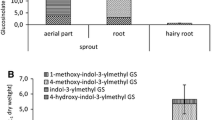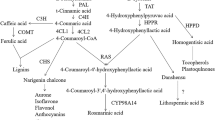Abstract
The effect of abiotic (salicylic acid, jasmonic acid and methyl jasmonate) and biotic (chitosan and yeast extract) elicitors on the growth and xanthone accumulation in two hairy root clones of Gentiana dinarica Beck. was studied. The obtained results showed that clone 3 was more responsive to elicitor treatment than clone D. The production of dominant xanthone norswertianin-1-O-primeveroside was not significantly affected by either of the abiotic elicitor tested but was stimulated with chitosan treatment. The highest concentrations of all elicitors strongly increased the content of xanthone aglycone norswertianin, but simultaneously reducing the production of its glycoside norswertianin-1-O-primeveroside. The most efficient in enhancing norswertianin production was a 7-day treatment with salicylic acid (200 μM) and chitosan (50 mg l− 1), which yielded a 7.7- and a 24-fold increase in norswertianin content, respectively. In addition, treatment with biotic elicitors caused the occurrence of new xanthone compounds that were not detected in other samples. Free radical scavenging activity of xanthones was carried out by DPPH assay, and norswertianin showed the strongest activity.




Similar content being viewed by others
Abbreviations
- ASA:
-
Ascorbic acid
- CH:
-
Chitosan
- DPPH:
-
1,1-Diphenyl-2-picrylhydrazyl
- DW:
-
Dry weight
- JA:
-
Jasmonic acid
- MeJA:
-
Methyl jasmonate
- NOR:
-
Norswertianin
- NOR-1-O-PRIM:
-
Norswertianin-1-O-primeveroside
- SA:
-
Salicylic acid
- YE:
-
Yeast extract
References
Angelova Z, Georgiev S, Roos W (2006) Elicitation of plants. Biotechnol Biotechnol Eq 20:72–83
Baenas N, Garcia-Viguera C, Moreno D (2014) Elicitation: a tool for enriching the bioactive composition of foods. Molecules 19:13541–13563
Baxter A, Mittler R, Suzuki N (2014) ROS as key players in plant stress signaling. J Exp Bot 65(5):1229–1240
Bayraktar M, Naziri E, Akgun IH, Karabey F, Ilhan E, Akyol B, Bedir E, Gurel A (2016) Elicitor induced stevioside production, in vitro shoot growth, and biomass accumulation in micropropagated Stevia rebaudiana. Plant Cell Tissue Organ Cult 127:289–300
Beerhues L, Berger U (1995) Differential accumulation of xanthones in methyl-jasmonate and yeast-extract treated cell cultures of Centaurium erythraea and Centaurium littorale. Planta 197:608–612
Bhattacharya A, Sood P, Citovsky V (2010) The roles of plant phenolics in defence and communication during Agrobacterium and Rhizobium infection. Mol Plant Pathol 11(5):705–719
Blois MS (1958) Antioxidant determinations by the use of a stable free radical. Nature 181:1199–1200
Brand-Williams W, Cuvelier ME, Berset C (1995) Use a free radical method to evaluate antioxidative activity. LWT Food Sci Technol 28:25–30
Conceição LFR, Ferreres F, Tavares RM, Dias ACP (2006) Induction of Hypericum perforatum L. cells by Colletotrichum gloeosporioides elicitation. Phytochemistry 67:140–155
Conrath U, Pieterse CMJ, Mauch-Mani B (2002) Priming in plant-pathogen interactions. Trends Plant Sci 7:210–216
Coste A, Vlase L, Halmagyi A, Deliu C, Coldea G (2011) Effect of plant growth regulators and elicitors on production of secondary metabolites in shoot cultures of Hypericum hirsutum and Hypericum maculatum. Plant Cell Tissue Organ Cult 106:279–288
Dornenburg H, Knorr D (1995) Strategies for the improvement of secondary metabolite production in plant cell cultures. Enzime Microb Technol 17:674–684
Fotie J, Bohle S (2006) Pharmacological and biological activities of xanthones. AntiInfect Agents Med Chem 5:15–31
Franklin G, Conceição LFR, Kombrink E, Dias ACP (2008) Hypericum perforatum plant cells reduce Agrobacterium viability during co-cultivation. Planta 227:1401–1408
Franklin G, Conceição LFR, Kombrink E, Dias ACP (2009) Xanthone biosynthesis in Hypericum perforatum cells provides antioxidant and antimicrobial protection upon biotic stress. Phytochemistry 70:60–68
Gadzovska S, Maury S, Delaunay A, Spasenoski M, Joseph C, Hagege D (2007) Jasmonic acid elicitation of Hypericum perforatum L. cell suspensions and effects on the production of phenylpropanoids and naphtodianthrones. Plant Cell Tissue Organ Cult 89:1–13
Gadzovska S, Maury S, Delaunay A, Spasenoski M, Hagege D, Courtois D, Joseph C (2013) The influence of salicylic acid elicitation of shoots, callus, and cell suspension cultures on production of naphtodianthrones and phenylpropanoids in Hypericum perforatum L. Plant Cell Tissue Organ Cult 113:25–39
Georgiev M, Pavlov A, Bley T (2007) Hairy root type plant in vitro systems as sources of bioactive substances. Appl Microbiol Biotechnol 74:1175–1185
Hostettmann-Kaldas M, Hostettmann K, Sticher O (1981) Xanthones, flavones and secoiridoids of American Gentiana species. Phytochemistry 20:443–446
Krstić D, Janković T, Aljančić I, Šavikin-Fodulović K, Menković N, Milosavljević S (2004) Phytochemical investigation of Gentiana dinarica. Biochem Syst Ecol 32:937–941
Lee EJ, Park SY, Paek KY (2015) Enhancement strategies of bioactive compound production in adventitious root cultures of Eleutherococcus koreanum Nakai subjected to methyl jasmonate and salicylic acid elicitation through airlift bioreactors. Plant Cell Tissue Organ Cult 120:1–10
Li B, Wang B, Li H, Peng L, Ru M, Liang Z, Yan X, Zhu Y (2016) Establishment of Salvia castanea Diels f. tomentosa Stib. hairy root cultures and the promotion of tanshinone accumulation and gene expression with Ag+, methyl jasmonate, and yeast extract elicitation. Protoplasma 253:87–100
Lukmanul Hakkim F, Kalyani S, Essa M, Girija S, Song H (2011) Production of rosmarinic in Ocimum sanctum cell cultures by the influence of sucrose, phenylalanine, yeast extract and methyl jasmonate. Int J Biol Med Res 2:1070–1074
Menković N, Šavikin-Fodulović K, Čebedžić R (1999) Investigation of the activity of Gentiana lutea extracts against Mycobacterium bovis. Pharm Pharmacol Lett 9:74–75
Murashige T, Skoog F (1962) A revised medium for rapid growth and bioassays with tobacco tissue cultures. Physiol Plant 15:473–497
Nanjo F, Goto K, Seto R, Suzuki M, Sakai M, Hara Y (1996) Scavenging effects of tea catechins and their derivatives on 1,1-diphenyl-2-picrylhydrazyl radical. Free Radic Biol Med 21:895–902
Negi JS, Bisht VK, Singh P, Rawat MSM, Joshi GP (2013) Naturally occurring xanthones: chemistry and biology. J Appl Chem 2013:1–9
Pavlik M, Vacek J, Klejdus B, Kuban V (2007) Hypericin and hyperforin in St. John’s worth in vitro culture: influence of saccharose, polyethylene glycol, methyl jasmonate and A. tumefaciens. Agric Food Chem 55:6147–6153
Pinto MM, Sousa ME, Nascimento MSJ (2005) Xanthone derivatives: New insights in biological activities. Curr Med Chem 12:2517–2538
Pitta-Alvarez S, Spollansky TC, Giulietti AM (2000) The influence of different biotic and abiotic elicitors on the production and profile of tropane alkaloids in hairy roots of Brugmansia candida. Enzyme Microb Technol 26:252–258
Radman R, Saez T, Bucke C, Keshavarz T (2003) Elicitation of plants and microbial cell systems. Biotechnol Appl Biochem 37:9–102
Rice-Evans C, Miller NJ, Bolwell PG, Bramley PM, Pridham JB (1995) The relative antioxidant activities of plant-derived polyphenolic flavonoids. Free Radic Res 22:375–383
Šavikin K, Menković N, Zdunjić G, Stević T, Radanović D, Janković T (2009) Antimicrobial activity of Gentiana lutea L. extracts. Z Naturforsch 64c:339–342
Shahidi F, Wanasundara PKJ (1992) Phenolic antioxidants. Crit Rev Food Sci Nutr 32:67–103
Singh PP, Ambika, Chauhan SMS (2012) Activity-guided isolation of antioxidant xanthones from Swertia chirayita (roxb.) H. Karsten (Gentianaceae). Nat Prod Res 26(18):1682–1686
Sirvent TM, Gibson DM (2002) Induction of hypericins and hyperforin in Hypericum perforatum L. in response to biotic and chemical elicitors. Physiol Mol Plant Path 60:311–320
Sivanandhan G, Arun M, Mayavan S, Rajesh M, Mariashibu TS, Manickavasagam M, Selvaraj N, Ganapathi A (2012) Chitosan enhances withanolides production in adventitious root cultures of Withania somnifera (L.) Dunal. Ind Crops Prod 37:124–129
Tocci N, Ferrari F, Santamaria AR, Valletta A, Rovardi I, Pasqua G (2010) Chitosan enhances xanthone production in Hypericum perforatum subsp. angustifolium cell cultures. Nat Prod Res 24:286–293
Tocci N, Simonetti G, Diodata DˋAuria F, Panella S, Palamara AT, Valletta A, Pasqua G (2011) Root cultures of Hypericum perforatum subsp. angustifolium elicited with chitosan and production of xanthone-rich extracts with antifungal activity. Appl Microbiol Biotechnol 91:977–987
Udomsuk L, Jarukamjorn K, Tanaka H, Putalun W (2011) Improved isoflavonoid production in Pueraria candollei hairy root cultures using elicitation. Biotechnol Lett 3(2):369–374
Vasconsuelo A, Boland R (2007) Molecular aspects of the early stages of elicitation of secondary metabolites in plants. Plant Sci 172:861–875
Vinterhalter B, Krstić-Milošević D, Janković T, Pljevljakušić D, Ninković S, Smigocki A, Vinterhalter D (2015) Gentiana dinarica Beck. hairy root cultures and evaluation of factors affecting growth and xanthone production. Plant Cell Tissue Organ Cult 121:667–679
Weathers PJ, Towler MJ, Xa J (2010) Bench to batch: advances in plant cell culture for producing useful products. Appl Microbiol Biotechnol 85:1339–1351
Wichtl M (1994) Teedrogen. Wissenschaftliche Verlagsgesellschaft, Stuttgart, pp 233–235
Wielanek M, Urbanek H (2006) Enhanced glucotropaeolin production in hairy root cultures of Tropaeolum majus L. by combining elicitation and precursor feeding. Plant Cell Tissue Organ Cult 86:177–186
Zhao J, Davis LC, Verpoorte R (2005) Elicitor signal transduction leading to the production of plant secondary metabolites. Biotechnol Adv 23:283–333
Zhao Z-J, Song Y-G, Liu Y-L, Qiao M, Zhai X-L, Xiang F-N (2013) The effect of elicitors on oleanolic acid accumulation and expression of triterpenoid synthesis genes in Gentiana straminea. Biol Plantarum 57(1):139–143
Zheng X-Y, Yang Y-F, Li W, Zhao X, Sun Y, Sun H, Wang Y-H, Pu X-P (2014) Two xanthones from Swertia punicea with hepatoprotective activities in vitro and in vivo. J Ethnopharmacol 153:854–863
Zhou M-L, Zhu X-M, Shao J-R, Tang Y-X, Wu Y-M (2011) Production and metabolic engineering of bioactive substances in plant hairy root culture. Appl Microbiol Biotechnol 90:1229–1239
Acknowledgements
The present work was supported by the Ministry of Education, Science and Technological Development of the Republic of Serbia, Grant No. 173015.
Author information
Authors and Affiliations
Contributions
BV produced and maintained in vitro cultures and designed and supervised the whole study. DKM and TJ provided plant material, performed phytochemical analysis and wrote the manuscript. DV helped with experimental design and performed statistical analysis of the data. BU contributed to the writing and correction of the manuscript.
Corresponding author
Ethics declarations
Conflict of interest
The authors have no conflict of interest to declare.
Additional information
Communicated by: Silvia Moreno.
Rights and permissions
About this article
Cite this article
Krstić-Milošević, D., Janković, T., Uzelac, B. et al. Effect of elicitors on xanthone accumulation and biomass production in hairy root cultures of Gentiana dinarica . Plant Cell Tiss Organ Cult 130, 631–640 (2017). https://doi.org/10.1007/s11240-017-1252-1
Received:
Accepted:
Published:
Issue Date:
DOI: https://doi.org/10.1007/s11240-017-1252-1




